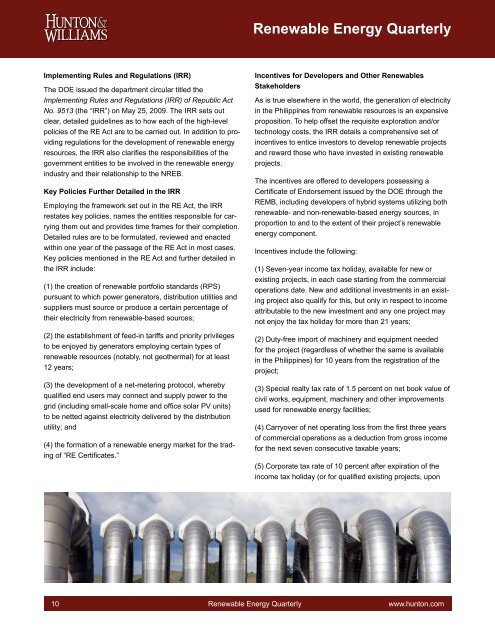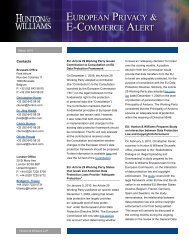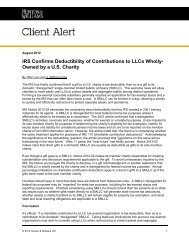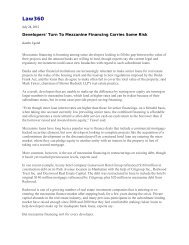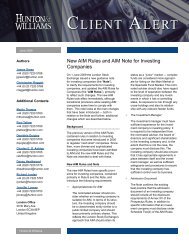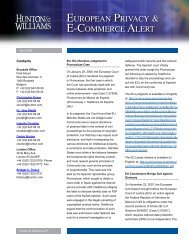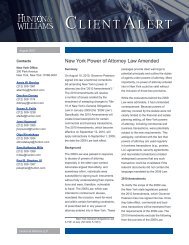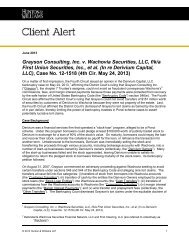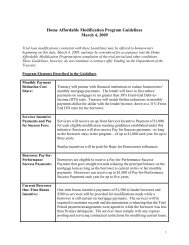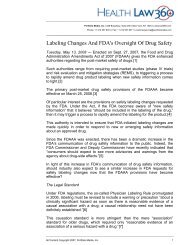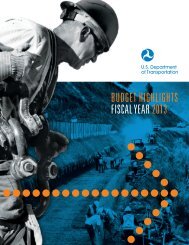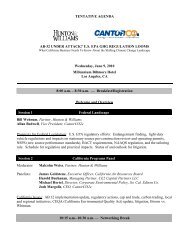Hunton & Williams Renewable Energy Quarterly, September 2009
Hunton & Williams Renewable Energy Quarterly, September 2009
Hunton & Williams Renewable Energy Quarterly, September 2009
Create successful ePaper yourself
Turn your PDF publications into a flip-book with our unique Google optimized e-Paper software.
<strong>Renewable</strong> <strong>Energy</strong> <strong>Quarterly</strong><br />
Implementing Rules and Regulations (IRR)<br />
The DOE issued the department circular titled the<br />
Implementing Rules and Regulations (IRR) of Republic Act<br />
No. 9513 (the “IRR”) on May 25, <strong>2009</strong>. The IRR sets out<br />
clear, detailed guidelines as to how each of the high-level<br />
policies of the RE Act are to be carried out. In addition to providing<br />
regulations for the development of renewable energy<br />
resources, the IRR also clarifies the responsibilities of the<br />
government entities to be involved in the renewable energy<br />
industry and their relationship to the NREB.<br />
Key Policies Further Detailed in the IRR<br />
Employing the framework set out in the RE Act, the IRR<br />
restates key policies, names the entities responsible for carrying<br />
them out and provides time frames for their completion.<br />
Detailed rules are to be formulated, reviewed and enacted<br />
within one year of the passage of the RE Act in most cases.<br />
Key policies mentioned in the RE Act and further detailed in<br />
the IRR include:<br />
(1) the creation of renewable portfolio standards (RPS)<br />
pursuant to which power generators, distribution utilities and<br />
suppliers must source or produce a certain percentage of<br />
their electricity from renewable-based sources;<br />
(2) the establishment of feed-in tariffs and priority privileges<br />
to be enjoyed by generators employing certain types of<br />
renewable resources (notably, not geothermal) for at least<br />
12 years;<br />
(3) the development of a net-metering protocol, whereby<br />
qualified end users may connect and supply power to the<br />
grid (including small-scale home and office solar PV units)<br />
to be netted against electricity delivered by the distribution<br />
utility; and<br />
(4) the formation of a renewable energy market for the trading<br />
of “RE Certificates.”<br />
Incentives for Developers and Other <strong>Renewable</strong>s<br />
Stakeholders<br />
As is true elsewhere in the world, the generation of electricity<br />
in the Philippines from renewable resources is an expensive<br />
proposition. To help offset the requisite exploration and/or<br />
technology costs, the IRR details a comprehensive set of<br />
incentives to entice investors to develop renewable projects<br />
and reward those who have invested in existing renewable<br />
projects.<br />
The incentives are offered to developers possessing a<br />
Certificate of Endorsement issued by the DOE through the<br />
REMB, including developers of hybrid systems utilizing both<br />
renewable- and non-renewable-based energy sources, in<br />
proportion to and to the extent of their project’s renewable<br />
energy component.<br />
Incentives include the following:<br />
(1) Seven-year income tax holiday, available for new or<br />
existing projects, in each case starting from the commercial<br />
operations date. New and additional investments in an existing<br />
project also qualify for this, but only in respect to income<br />
attributable to the new investment and any one project may<br />
not enjoy the tax holiday for more than 21 years;<br />
(2) Duty-free import of machinery and equipment needed<br />
for the project (regardless of whether the same is available<br />
in the Philippines) for 10 years from the registration of the<br />
project;<br />
(3) Special realty tax rate of 1.5 percent on net book value of<br />
civil works, equipment, machinery and other improvements<br />
used for renewable energy facilities;<br />
(4) Carryover of net operating loss from the first three years<br />
of commercial operations as a deduction from gross income<br />
for the next seven consecutive taxable years;<br />
(5) Corporate tax rate of 10 percent after expiration of the<br />
income tax holiday (or for qualified existing projects, upon<br />
10 <strong>Renewable</strong> <strong>Energy</strong> <strong>Quarterly</strong> www.hunton.com


